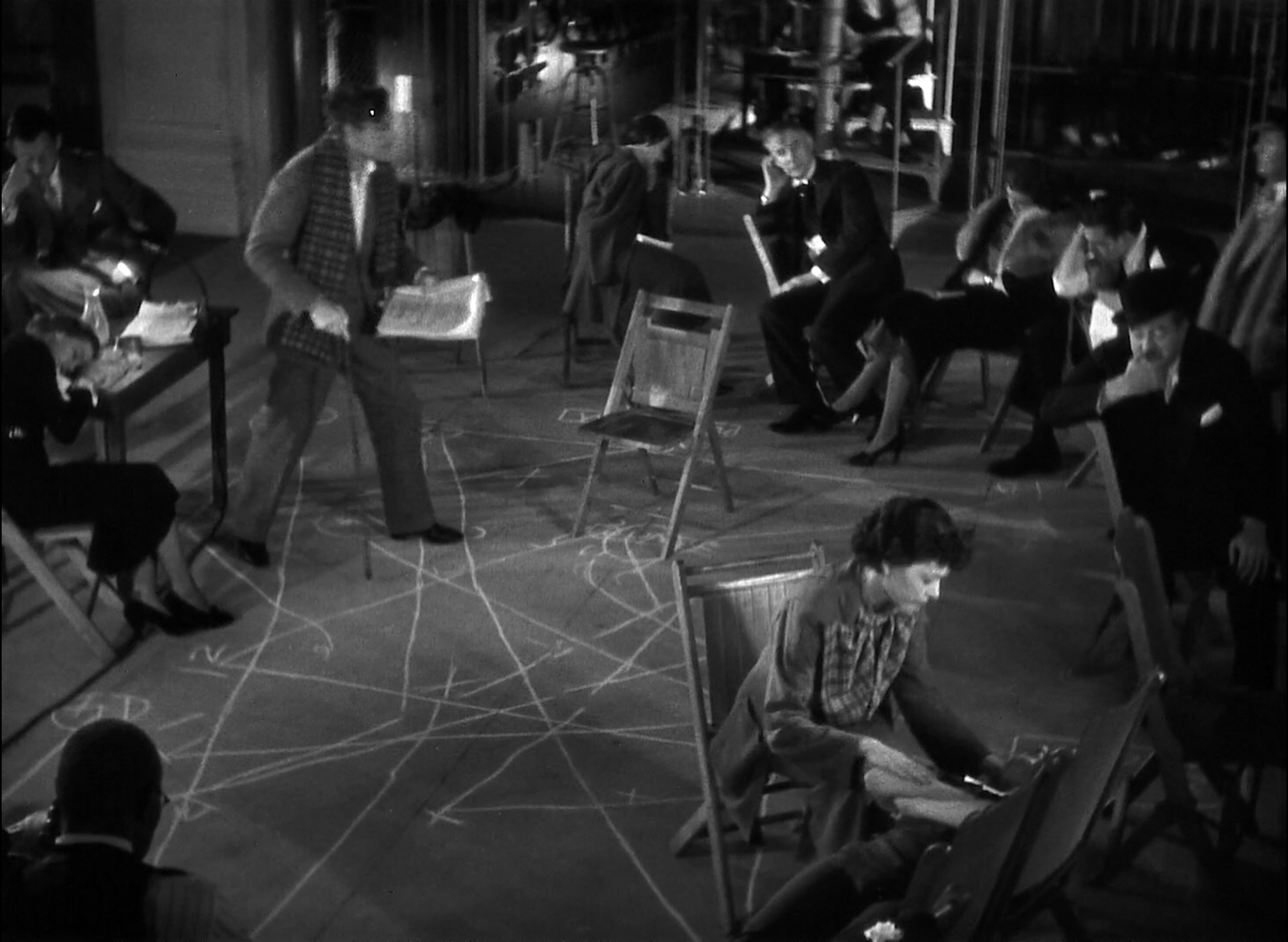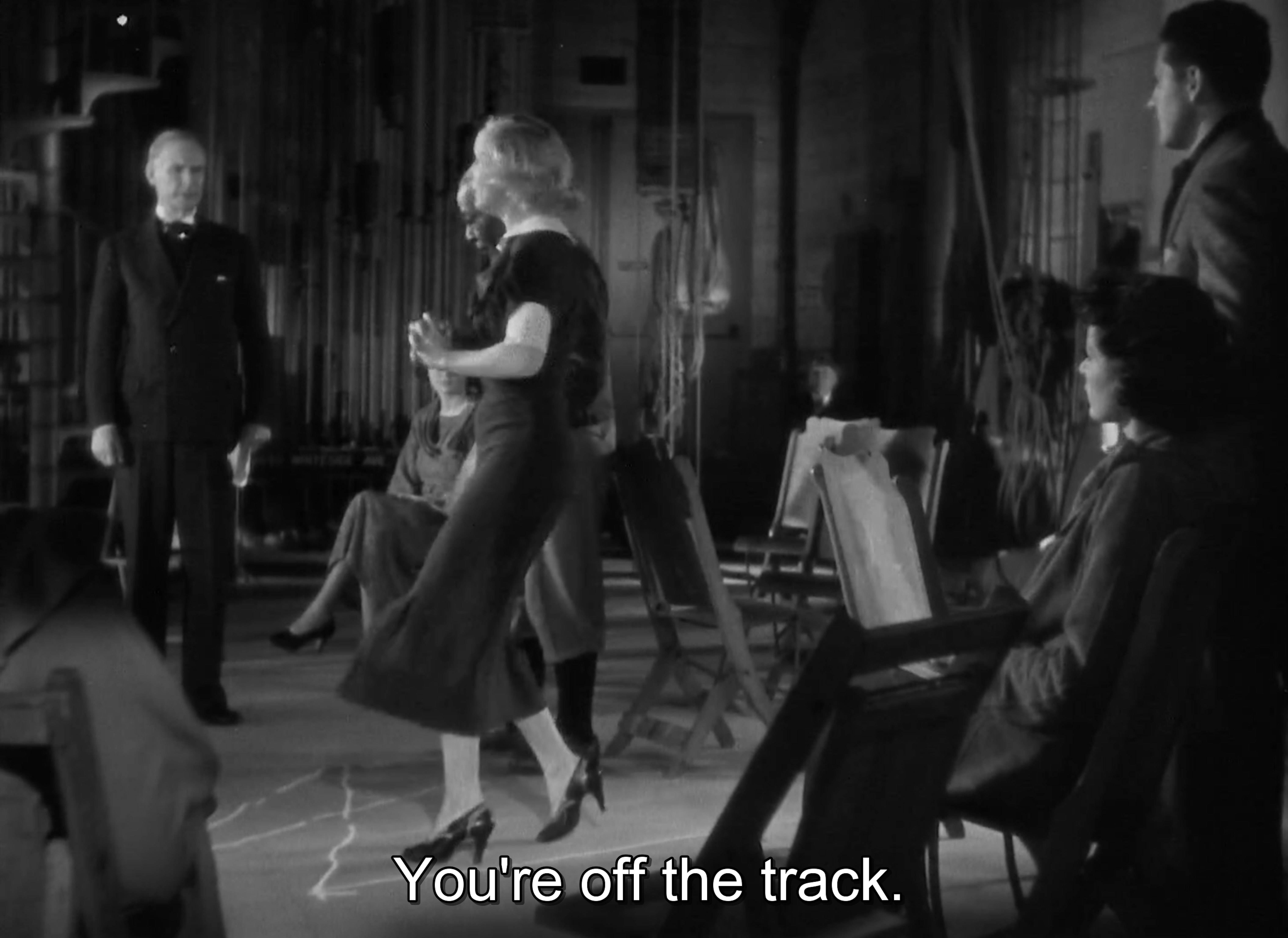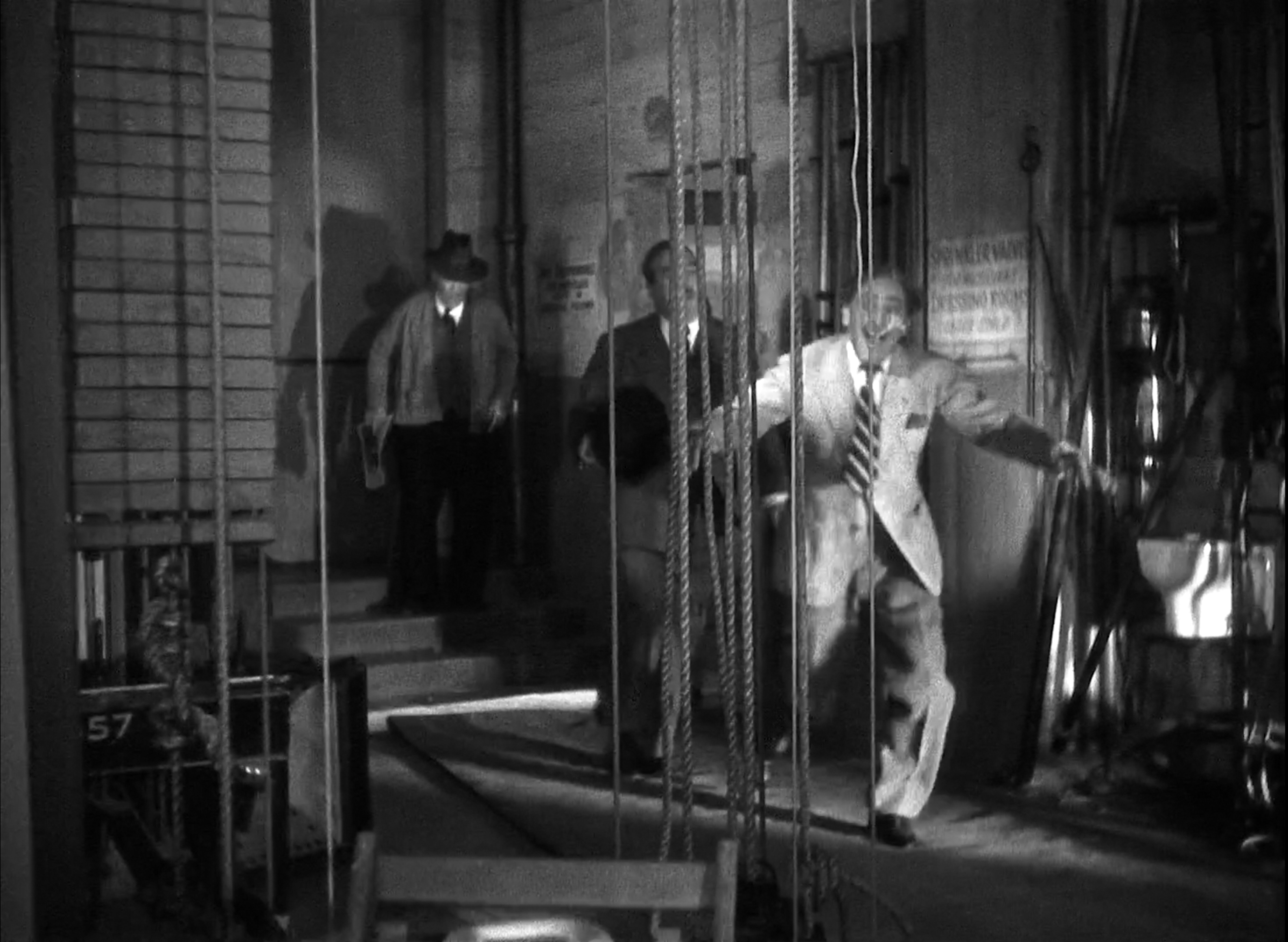The Edge of Linear Cinema: Howard Hawks's Twentieth Century
 Sunday, June 30, 2019 at 4:48PM
Sunday, June 30, 2019 at 4:48PM Aaron Dowdy and John Winn
[ PDF Version ]

Figure 1. Image from Twentieth Century.
“We’re not people. We’re lithographs.”
––Carole Lombard, Twentieth Century (dir. Howard Hawks, US, 1934)
Introduction
The simplest way to elucidate relation might be the drawing of a line. Lines can connect points, demarcate boundaries, trace movements, and render the seemingly immaterial passage of time sensible. For Jean-Luc Nancy, such a conceptualization figures the line as aesthetically transversal, suggesting its irreducible plurality. By this, he means that the line traverses and mediates myriad movements and processes, yet never contains these pluralities within “a single graphic notation” that subsumes them all.[1] Dancers might follow lines of notation to reenact a past performance, while generals might direct regiments through a territory in accordance with cartographic lines. Put simply, lines narrate the diversity of relation, and as such we can understand them to describe, record, and condition an attention to this diversity’s presence as well as its traceability.
Considering the line in this way opens the question of its mediation. This article moves to investigate the lines of cinema by asking simply: is cinema a graphic medium involved in the tracing and narrating of relation with lines? We might begin to answer this question by locating particular instances of visual lines, following cinema’s micro-movements as lines of action, or even suggesting that lines are drawn by the intuitions of the spectator.[2] This kind of thinking can arguably already be found in a more figural understanding of Alexandre Astruc’s caméra-stylo, where cinematography can be considered as a tracing of lines.[3] While this opens a rich discourse about the iconographic and diagrammatic dimensions of the image, we move to address the dominant “line” found in discourses on cinema often understood as its “single graphic notation”: the line of linearity.
In discussions of cinema and classical cinema in particular, the line of linearity is offered as a figure that orders the image and its narrative along a unified continuum. However, we aim to complicate and elaborate this formal figure of linearity as pertaining more to the aforementioned diversity of the line, or rather as a line among many within cinema. To clarify this, we will consider Howard Hawks’s Twentieth Century (US, 1934), which paradoxically maintains the coherency of linearity while conveying a heterogenous vision of lines that seem to exceed and subvert it. We argue that Twentieth Century invites spectators to read this paradoxical entwining as the edge of linearity, where the omnidirectional and polyvocal lines at play within the image function as the confluent force of its linear composition. Before analyzing Twentieth Century’s method for tracing the edge of linear composition, we offer a sketch of the line’s significance for articulating the relations of classical cinema.
Linear and Lineal Cinema
There are two techniques of the line that this discussion of classical cinema aims to articulate. The first is linear, referring to the capacity for films to be read in terms of the relational ordering of gestures, movements, interpretations, and emotions according to a coherent narrative. The second is lineal, referring to the capacity for films to be read in terms of the relational interstices that might escape such ordering—gestures or movements that invite spectators to read beyond the order of the image. As Tim Ingold suggests, the linear abstracts and subsumes heterogeneity along the univocal form of an ordering line, while lineality registers the movements of this heterogeneity as lines.[4] In this article, to approach the lineality of cinema is not only to foreground those images and movements that exceed the bounds of the narrative, but also to consider them with regard to narrative’s linear figurations, such that the two must become imbricated and enfolded in the mutual constitution of narration.
Linearity can be said to function as a technique that invites critics, scholars, and spectators to cohere and compose the various movements of the image along a seemingly univocal line. As David Bordwell suggests, the formal techniques of the narrative’s mise-en-scène and montage synchronize with the plot and the inferences made by spectators, coalescing to enact a coherent thread of events and expectations.[5] In other words, linear cinema regulates and interweaves the heterogeneity of the image and the plurality of spectatorial engagements along a coherent line, integrating differential relations along straightforward connections. Thus, for scholars Bordwell, Janet Staiger, and Kristin Thompson, the pattern of narration in classical Hollywood “consists of a linkage which resembles a game of dominoes, each dangling cause matched by its effect in the following scene.”[6] Spectators read such a cinema by drawing out connections that overlay with the connections drawn out by the film. Each film organizes along its particular cohering line, and each spectator is prompted to follow or double that line.[7]
Yet both the image and the spectator exceed this linear regulation. Accidents or contingencies on the screen might unhinge the linear progression of events, while political or cultural differences between the film and its spectator might lead to a reading oriented against the film, accentuating subterranean aspects that evade the narrative’s ordering. That is, classical cinemas can also draw out lines that destabilize the univocity of their linearity. By inviting spectators to draw out an initial line in accordance with that of the filmic narrative, such films inadvertently afford spectators and images with the capacity to locate its other enmeshed lines.
To distinguish these lines from the linearity of cinema, we will refer to them as lineal. These linealities could be flourishes, bodies, or things drawing themselves out in movements, dialogue, or gestures. These lines can be followed or sought out by the spectator whether or not they have to do with the apparent narrative. This is why film theorists like Raúl Ruiz can suggest that every film bears other films within it, opened upon by following these lineal lines, or what he calls a film’s “thousand paths, [its] thousand short-cuts and secret passages.”[8]
Yet despite the potential invitation to the viewer to find secret films within the archive of cinema by following the image’s linealities rather than linearities, cinemas like classical Hollywood are largely set up within the edges of a coherent linearizing structure. Lineality, as it implicitly appears in the work of Ruiz as well as that of Bordwell, would then seem to demarcate deviations from linearity, thus failing to address the supple plurality of linearity as itself a kind of relational line. The linealities of cinema, instead, must be understood as the lineaments of linearity’s projected coherency. If such is the case, then spectators might be able to remain with the linear flow of Hollywood while sensing its constitutive lineality.
Arguably, there is a history of films that can be said to presuppose this relation of both linearity and lineality within the model of classical Hollywood; these films work to exemplify this relation or to encourage its being read as such by the spectator. One such film is Howard Hawks’s Twentieth Century, a film that we argue provides a visual method for tracing the linealities that weave with the cohering edge of linearity.
Twentieth Century’s Lines
Formally, Hawks’s Twentieth Century is set up rather evidently as itself a line. Its drama begins in a theatre, moves to a train, and then returns in the end to the theatre: A to B to A. The train—from the Latin trahere meaning to draw—reiterates this form within the narrative, as it is shown to trace itself out along its tracks perfectly, linearly cutting through space.[9] This allows the viewer to get the sense visually that the chaotic and dramatic action occurring within the train is contained by the linearizing and cohering movement of the train itself. There is then an edge to the chaotic lines of action embodied in the linearity of the train.

Figure 2. Image from Twentieth Century.
The theatre also stages the actors linearly, wherein they follow the lines of their scripts as well as the director’s draconian orders. Etymologically, the term direct even refers to a theoretical line followed, something arranged in lines, or a straightening out of strewn parts into a line.[10] Like the train, the setting of the theatre suggests that the action, even if it is not explicitly linear, is being linearized. However, it is precisely these lines or linings that fill these linearizing settings, that fill these coherent lines, to which Hawks draws attention.
Hawks does not simply demonstrate the containment of chaotic lines; he also draws attention to the excessiveness of lines that spill out of their linearizing containers. In the beginning of the film, the spectator is introduced to a rehearsal for an upcoming play. Its director, Oscar Jaffe (John Barrymore), draws a line with chalk across the stage upon which he expects the lead, Lily Garland (Carole Lombard), to exact with her movement: a linear track to be linearly traced as with the train. It is itself a direction, a vector, a pathway. By literally drawing out the line, we are drawn to Jaffe’s as well the medium’s expectations of linear form. Yet in her attempt to follow his line, Lily misses, goes off the rails, so to speak, and traces out a new line that is hers alone. Thus, the audience is invited to mark her deviation from his linearizing line as another kind of line, which we are calling lineal. What Hawks does, then, is invite spectators to draw the line of her actual drift while keeping in mind the linearizing line meant to cohere her movement. To paraphrase the often quoted remark of Paul Klee: we are moved to render visible the lines that remain unmarked despite their being drawn.[11]
Thus we can understand Jaffe as a linearizing force and Garland as a lineal errancy. Garland’s ability to derail Jaffe’s attempt to order her movement infuriates him. His manipulative ire pushes Garland over the edge, causing her to emotionally break down. Jaffe finds this breakdown to be a talented performance. In bearing witness to her capacity for greatness, he draws a line across her cheek, commenting “Duse had that modeling,” referring to the Italian actress Eleonora Duse. It is precisely due to Garland’s lineal drift from his linearized role for her, constituted by the gestures of her breakdown, that Jaffe draws this unmarked line upon her cheek. He moves to cohere and claim that version of her, the one which is actually her lineality. However, for Jaffe, the line across her cheek marks instead a historical lineage of actresses, a line of affection, a line of transformation. Drawing it is a way to inscribe her body again with his linearizing force.
Yet this attempt at integrating Garland’s errancy within the mold of linear direction ultimately fails. Following this performance Garland becomes a star, undermining Jaffe’s capacity to claim her deviance within the demarcations of his linear direction. Eventually realizing that it is her lineal drift that underwrites Jaffe’s monomaniacal linearity, Garland frees herself from him, fleeing for Los Angeles.

Figure 3. Image from Twentieth Century.
Without Garland, without a subject to linearize, Jaffe proceeds to have his own breakdown, deviating from his embodiment as a linearizing force into his own series of lineal errancies. He emits a barrage of lineal actions, derailing into performances of disparate accents and speeches while flailing about the theater. This corporeal incoherence seems incapable of causally binding the image so important to the linear form undergirding the film. Rather than drawing out a line of direction, Jaffe’s trauma forces him to drift with the contours of the theatrical place, conjuring past performances, bumbling against walls and railings. The entire network of relations channeled and maintained by the director begins to crumble under these pointless gestures.
In this case, the lineal functions as a kind of suspension or crack of Jaffe’s linear ordering, inviting spectators to contemplate the spacing between the points said to give logical form to linearity. Giorgio Agamben suggests that such gestural lines are “the display of mediation, the making visible of means as such.”[12] For Agamben, gesture expresses the medial means that undergird all relations without consolidating in ends or points. Withdrawn from ends and connections, this gestural dimension keeps the image open to change. The incoherent gesturality drawn out in this sequence of Twentieth Century seems to call forth countless lines that are never cut off but always suspended, discordant, and delirious.
However, rather than asserting that such suspensions function as deviations from the order of things, we suspect that such gestures might intimately entwine with the order of linearity. Against all odds, these lineal gestures are performed concomitantly to the film’s linear coherence that scholars such as Robin Wood understand as “symmetrical” and “organic construction.”[13] As the remainder of this article aims to explicate, these lineal asymmetries and unstable performances appear to compose the film’s overarching symmetry or linearity.
This understanding of linearity as composed of linealities, of suspended and incoherent gestures, is most evident in the final act of the film when Jaffe conspires to repossess Garland for a stage production after finding her on the titular train from Chicago to New York. He begins to script his plan in real time precisely through strategically organizing his still incoherent gestures. Though scripting can be understood as a written text, we here emphasize the texĕre of text as a weaving or rather a texture that seems to inscribe or bind movements together. In other words, the incoherent gestures act out a kind of writing that inscribes the image with its linearity: the lineal orders the linear.
This real-time scripting begins to “repeat in miniature the complex web” appropriate of a play, as J. Hillis Miller describes literary lines in general.[14] Just as the viewer might negotiate a secret film at cinema’s edge by following its lineality, the characters negotiate a secret play, tracing out lines that are hidden to both them and to the viewer but which nonetheless seem to organize their actions. As the epigraph to this article conveys, the characters become more lithographs or script producers than people, and they are aware of this fact. Ultimately this gestural scripting leads to the reaffirmation of order, with Lily and Jaffe back in New York rehearsing another play at the film’s conclusion. Thus this lineal scripting, even as it errs, can nonetheless be said to also linearize, or to be included as the individuating matter within the linear coherence that the film ultimately asks the spectator to affirm. The edge demarcates this site of resonance between linearity and lineality as two antinomic lines of cinema, whereby neither subjugates nor disrupts the other, each rather weaving to compose narrative flow.
Conclusion
This article has shown two techniques of the line in cinema. The classical mode of narrative understands cinema as a linear medium, a line on which any and everything is made sensible. However, there is another mode of cinema, which we can call its errant mode, that considers each element of cinema as drawing out lines, even if they do not correspond to the narrative. We are calling these lines lineal, the presence of which appears to occur outside the scope of linearity, but not outside the image. Though linearity orders the classical image of cinema, this ordering is rendered sensible by the edge of its composition. Classical Hollywood tends to obfuscate this edge in an attempt to foreclose the capacity for spectators to relate to the image’s plurality at play outside of or entwined with its linear lines. Spectators might instead trace out counterlines within the image—secret linealities written against classical form. Yet as we have argued in this paper, linearity might also invite spectators to contemplate the edge of its composition. Twentieth Century provides a method to do just this. Composition never comes from elsewhere as an ideal form binding the errancies of cinema, but rather writes itself with the lines available to it, erring and ordering with them.
Notes
[1] Jean-Luc Nancy, The Pleasure in Drawing (New York: Fordham University Press, 2013), 41.
[2] For more on this third approach, see Alfred Lukyanovich Yarbus, Eye Movements and Vision (New York: Plenum Press, 1967).
[3] Alexandre Astruc, “The Birth of the New Avant-Garde: La Camera-Stylo,” in The French New Wave: Critical Landmarks, ed. Peter Graham (London: BFI, 2009). For an overview of the aesthetic category of the figural, see Jean-François Lyotard’s Discourse, Figure (Minneapolis: University of Minnesota Press, 2011) or D. N. Rodowick’s Reading the Figural, Or, Philosophy After the New Media (Durham, NC: Duke University Press, 2001).
[4] Tim Ingold, Lines: A Brief History (Abingdon, UK: Routledge, 2007).
[5] David Bordwell, The Poetics of Cinema (Abingdon, UK: Routledge, 2007).
[6] David Bordwell, Janet Staiger, and Kristen Thompson, The Classical Hollywood Cinema: Film Style and Mode of Production to 1960 (New York: Columbia University Press, 1985), 66.
[7] For an account of doubling the lines of and in narrative, see J. Hillis Miller’s Ariadne’s Thread: Story Lines (New Haven, CT: Yale University Press, 1992).
[8] Raúl Ruiz, Poetics of Cinema (Paris: Dis Voir, 1995), 81.
[9] Oxford English Dictionary, 2nd ed. (Oxford: Oxford University Press, 1989), s.v. “train.”
[10] Ibid., s.v. “direct.”
[11] Paul Klee, The Thinking Eye: The Notebooks of Paul Klee, trans. Ralph Manheim (New York: Wittenborn, 2013), 76.
[12] Giorgio Agamben, Infancy and History: The Destruction of Experience (New York: Verso Press, 1993), 155.
[13] Robin Wood, Howard Hawks (Detroit, MI: Wayne State University Press, 2006), 70, 84.
[14] Miller, Ariadne’s Thread: Story Lines, 69.
Aaron Dowdy is a graduate student at Columbia University. His research focuses on twentieth century philosophy, cinema and other forms of visuality, and the ways in which they can be understood together through diagrammatic figures.
John Winn is a PhD student at Duke University. His research considers the relations between classical Hollywood, philosophy, and technology.
Reader Comments